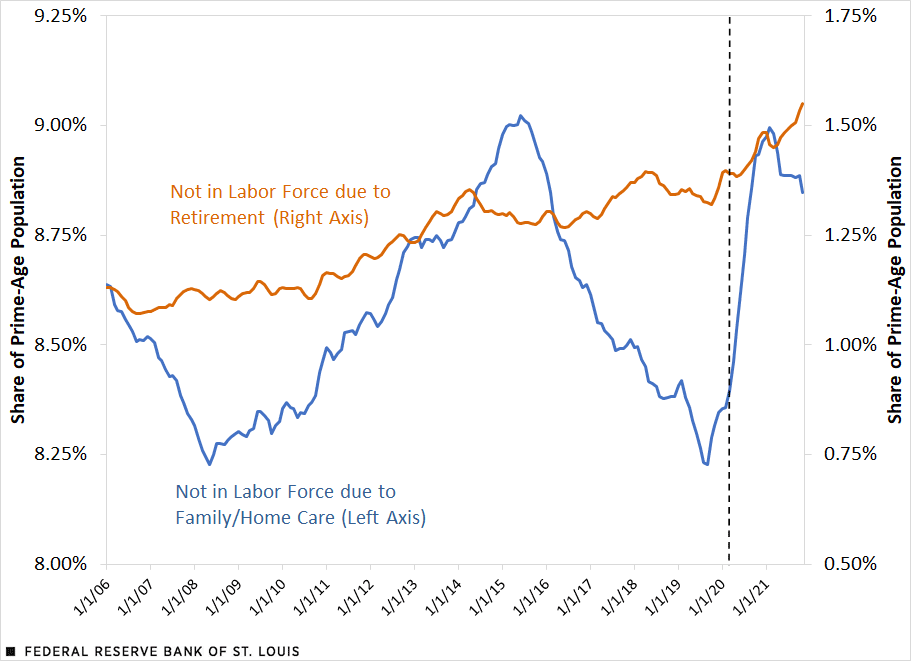Family Needs Affect U.S. Labor Participation of Prime-Age Workers
In a December blog post, we discussed some of the effects of the COVID-19 pandemic on the labor market, particularly on the decision of older individuals to retire, which has been a salient topic of discussion. In this blog post, we look at the labor force participation decisions of prime-age individuals—those between 25 and 55—and evaluate to what extent the pandemic continues to play an important role in their employment decisions.
Prime-age individuals have the strongest attachment to the labor market, and close to 80% of them are employed. Between January 2018 and February 2020—that is, a period before the pandemic—17.7% of all prime-age individuals were neither employed nor looking for a job; in other words, they were out of the labor force. During the first three months of the pandemic—from March to June 2020—this fraction increased by slightly over 1 percentage point. Note that the fraction of unemployed individuals—those not employed but actively looking for work—in this age group increased by a much larger extent in this period, but our focus here is on individuals that are not actively looking for a job. Nowadays, the fraction of prime-age individuals not in the labor force sits close to 0.6 percentage points, or about 720,000 people, above the pre-pandemic levels. What has prompted the change in behavior for some of the people in this age group?
Reasons for Not Being in the Labor Force
To answer this question, we use data from the Current Population Survey and examine the reasons prime-age individuals give for being out of the labor force. These reasons can be the following:
- taking care of the house or family
- retirement
- unable to work, disabled or sick
- attending school
- other
Around half of all prime-age individuals not in the labor force reported taking care of the house or family as their reason, and close to 8% reported being retired, on average, in 2018 and 2019. We focused on these two reasons because the share of people who report them has increased during the pandemic, and these reasons have been frequently highlighted as likely drivers of the decrease in labor force participation since the pandemic began.The share of prime-age workers not in the labor force that reported being unable to work, disabled or sick, or in school fell since the beginning of the pandemic.
The figure shows the percentage of prime-age individuals out of the labor force due to retirement or family and home care, relative to all prime-age individuals. We smoothed the series using a 12-month moving average.
Key Reasons Why Prime-Age People Are Not in the Labor Force

SOURCES: Current Population Survey and authors’ calculations.
NOTES: The vertical dashed line marks the start of the pandemic. Data are 12-month moving averages and end in November 2021.
Since 2006, the proportion of those retired has slowly increased, and while this share is higher now than before the pandemic, it appears to be a continuation of a trend that started several years before COVID-19.
We observe a different pattern in the share of prime-age individuals who are out of the labor force because of family or home care. This share steadily rose between 2009 and 2015, but strongly decreased thereafter until late 2019. Since the beginning of the pandemic, the proportion increased once more and did so quite sharply. Despite the rapid recovery in employment and the recent low levels of the unemployment rate, the share of prime-age individuals out of the labor force because of family or home care reasons continues to hover at high values. It is possible that health concerns and difficulties in child care options are taking a toll on some individuals’ employment decisions.
Do They Want Jobs?
Finally, we looked at whether prime-age workers who are neither employed nor actively looking for a job do, in fact, want a job. The fraction of those not in the labor force reporting that they want a job was close to 10%, on average, between 2018 and 2019. During the first few months of the pandemic, the number increased to close to 15% but more recently stands at 12%.
Our discussion here suggests that the reasons for the increase in nonparticipation are not strongly related to a weak economy or insufficient labor demand, but rather due to a change in individuals’ desire to supply labor in the market.
Notes and References
- The share of prime-age workers not in the labor force that reported being unable to work, disabled or sick, or in school fell since the beginning of the pandemic.
Citation
Maximiliano A. Dvorkin and Maggie Isaacson, ldquoFamily Needs Affect U.S. Labor Participation of Prime-Age Workers,rdquo St. Louis Fed On the Economy, Jan. 13, 2022.
This blog offers commentary, analysis and data from our economists and experts. Views expressed are not necessarily those of the St. Louis Fed or Federal Reserve System.
Email Us
All other blog-related questions



